DEBUNKING THE MYTH OF THE HOLOCAUST
Photos of German concentration camps below show that prisoners had access to banks, hospital clinics, swimming pools, libraries, leisure halls and even brothels. When their time was up, they were released from the camp.

These pictures show the German National Socialists treated concentration camp prisoners humanely.
The photos of dead corpses being thrown into pits were of the prisoners who had died in typhus epidemics. Typhus is a disease that causes diarrhea and severe and rapid weight loss. People who die from it are usually emaciated in appearance. It is prone to occur in people whose immune resistance is lowered by insufficient food intake. Loss of weight due to typhus illness in already underweight people causes the skeletal appearance of many of its victims. Another big killer in the camps was TB (tuberculosis). This also caused a skinny appearance in sufferers as it was a wasting disease like typhus.
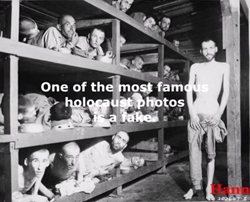

Atrocity propaganda: The faking of photos is often employed in atrocity propaganda campaigns that are done to demonize a nation. This one is a famous photo from Life magazine.
Towards the end of the war, when the bombing of the Allied forces became severe, cutting off the food supply to the camps, the camps’ burial system was overwhelmed by the number of people who died from typhus. In addition to the camp inmates, these camps had to bury people who lived in the surrounding locale.
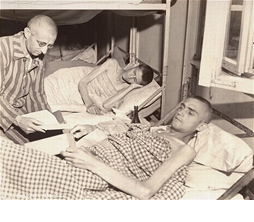

LEFT: Prisoner reads prayers to two survivors in the infirmary barracks in Dachau. Dachau Scrapbook. RIGHT: 1 million cases of typhus in the Ukrainian Holodomor in 1932-33, and 1.4 million cases of typhus during World War I and Russian Civil War (1913-1922). Typhus used to be a common disease during wartime and famines. Source of table: Davies, Robert W.; Wheatcroft, Stephen G. (2010). The Years of Hunger: Soviet Agriculture 1931–1933
Typhus was called “gaol fever” in England. Other names for the disease are camp fever, jail fever, hospital fever, ship fever, famine fever, putrid fever, and petechial fever (because of the rash, “petechiae”, it produces). Anne Frank, who was sent to the Bergen-Belsen camp, died of typhus, which she contracted at the camp.

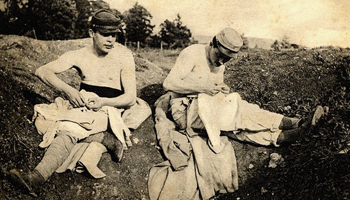
Left: Typhus is spread by the louse (plural is “lice”), which are carriers of the organism called Rickettsia prowazekii that causes this illness. Right: Soldiers living in the trenches picking off lice from their clothes during WWI.
Typhus was a common disease in prisons, concentration camps and other places where large numbers of people collected, in the pre-antibiotic age.

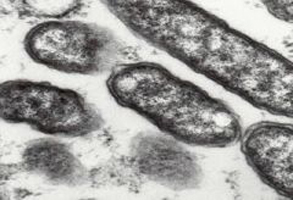
Rickettsia prowazekii is a bacterium that causes epidemic typhus.
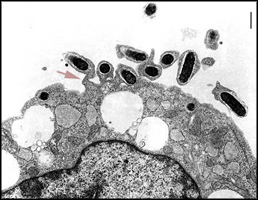

Rickettsia prowazekii, an organism that causes typhus, seen under an electron microscope. On the left, the bacteria (bullet-shaped organisms with black centers) can be seen attacking a cell.
Is this a photo of an inmate in a German concentration camp?

IMG: A photo of an American prisoner in a Civil War era concentration camp. Photo from Andersonville
Typhus was rampant during the American Civil War, and sick prisoners in Civil War concentration camps looked just like the ones in German concentration camps.
What is Gaol Fever?
Symptoms include severe headache and muscle pain, fever, delirium and a characteristic rash […]
The cause of epidemic typhus is Rickettsia prowazekii, bacteria usually transmitted by body lice. It thrives in overcrowded places where sanitation is poor and immune systems are weakened by hunger. Outbreaks were common in armies well into the 20th century, and it often killed more soldiers than combat, as in Napoleon’s 1812 retreat from Moscow. The last outbreaks of gaol fever to kill significant numbers of Europeans were in Hitler’s concentration camps.
It commonly occurred in the appalling conditions of Britain’s prisons before Victorian reformers cleaned them up, hence the name ‘gaol fever’. Being held in prison before trial could be tantamount to a sentence of death, and more died of gaol fever in the 1700s than were executed.

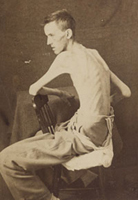


Four sick prisoners in American Civil War era concentration camps. Andersonville
Newham Prison (left) was called hell on earth. Durham Prison (center) and Fleet Prison (right). Typhus was common in these places, and was called “gaol fever”. Many epidemics in the 19th century and earlier attributed to “plague” were actually typhus epidemics.


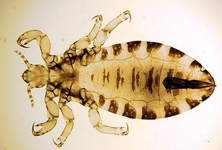
![]()
Left: Mother and sick child in a British concentration camp during the Boer War. Center-left: A woman and sick child in a Boer War era British concentration camp. Center-right: : Lice carries the bacteria (Rickettsia prowazekii) that causes typhus. Right: A sick child in a concentration camp during the Boer War.
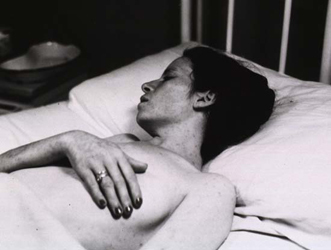
Woman with a typhus rash. Joseph Stalin’s first wife, Kato Svadnize, died of typhus at age 22. Her relative said that she had spots on her body, and when the rash turned black, they thought she was going to die. If a typhus rash stayed red, many people believed the patient would survive the disease. Typhus was a common disease in the first half of the last century and earlier.
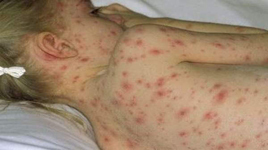

Typhus rash
The National Socialists tried to counter typhus disease epidemics by shaving the heads of the prisoners. Lice, which are the carriers of the bacteria that cause typhus, live in hair and clothes.
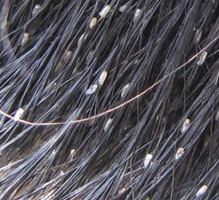

Nits (lice eggs) in hair. They are slightly smaller than sesame seeds. On the right, a close-up of nits.
This is why you see many prisoners in German concentration camps with shaven heads. (Note typhus is a different disease to typhoid. Typhoid is a gastrointestinal disease that is caught from eating or drinking contaminated food and liquids. Typhus and typhoid are commonly confused with one another.)


Left: Shaving heads at Sachsenhausen Camp. Right: Inmates walking in Auschwitz Camp, some with shorn hair.
In addition, the National Socialists tried to stop the epidemic by fumigating the clothing and bedding of the prisoners to kill the lice and eggs that carried the bacteria causing typhus. They would disinfect clothes, sheets, pillow cases and blankets by hanging them on racks and releasing Zyklon gas into the delousing cubicles to kill the lice.
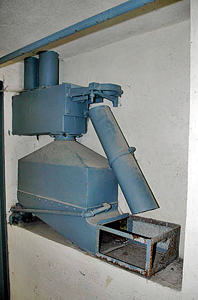
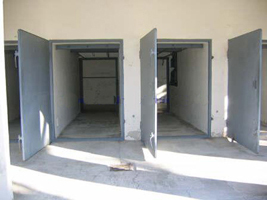
A dispenser that supplied hydrogen cyanide gas (Zyklon B) to the delousing chambers (chambers to disinfect clothes and similar materials) like the ones on the right. The delousing chambers were too small to be used for killing large numbers of people.
Americans used DDT powder during WWII to kill lice and control typhus epidemics, and Europeans, including Germans, used hydrogen cyanide (hydrocyanic acid). Zyklon B is the German name for hydrogen cyanide. Hydrogen cyanide is also known as prussic acid.
Hydrogen cyanide (Zyklon B) pellets were placed into dispensing machines like the Degesch machine above. The insecticide was released in the form of gas into chambers that held the clothes and other items for disinfection, and delousing took place that way.

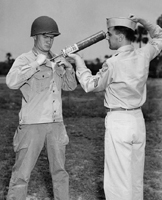
Left: Cans containing hydrogen cyanide pellets (Zyklon B). Right: American soldier applies DDT powder to a fellow soldier.

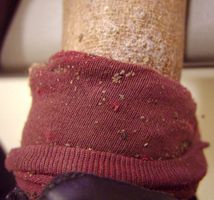
Left: During WWII, Americans used DDT powder to delouse hair and clothes. Right: Lice infestation of clothing.
Somehow the story of Germans trying to save the lives of prisoners, by controlling the epidemics of typhus by fumigating clothing and bedding with cyanide gas to kill the bacteria-carrying lice, got turned into the “Germans gassed 6 million Jews to death” myth.

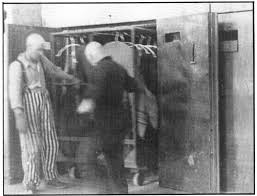
Left: Lice on clothing. Right: Inmate and officer working at a delousing chamber. In the delousing procedure, lice in the clothes was killed. In the photo, the racks hold clothing. The racks are mobile and so can be slid in and out of the chamber. Clothes hangers can be seen on the racks.
Despite claims that the National Socialists killed prisoners in shower rooms by releasing cyanide gas into them, many scientists, including a chemist who worked at the Max Planck Institute, could not find any evidence that shower rooms were used for killing inmates by gas.


Left: Deloused clothing hung up outside the four disinfection chambers, April 1945. Dachau (Whale). Right: Doors of the disinfection chambers for delousing clothes. Note the doors have been painted over to hide the signs warning “Gas! Biohazard! Do not open!”
Also, Holocaust revisionist scientists and other experts found no evidence that the gas cubicles that were used for delousing clothes were used to kill humans. The fumigation cubicles were too small for one thing, and could not fit the dozens of people into them that they would have had to have done for the “six million gassed by cyanide gas” story to be true.
On the whole, the small fumigation cubicles were impractical for gassing people, especially large numbers of people.

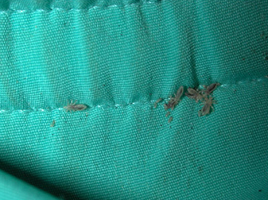
Lice and nits prefer to settle in the seams and creases of clothing.
Furthermore, you can see from the pictures of the de-lousing fumigation cubicles that they were equipped with racks and hangers, on which clothes and bedding would be draped and hung.
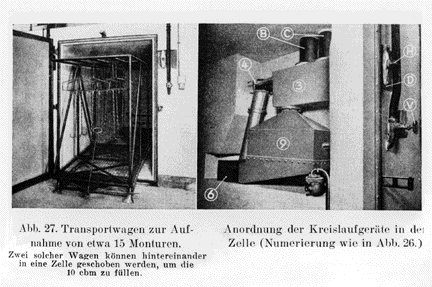
IMG: Delousing cubicles in a National Socialist concentration camp to fumigate clothes and other personal belongings of the prisoners. The mobile racks can be moved in and out of the cubicles.
More discussion about the clothes de-lousing gas cubicles below:
- The Website of Carlos Whitlock Porter: Auschwitz and Surroundings (link)
- Friedrich Paul Berg: Zyklon B and the German Delousing (link)
- Whale: Gas shelters and delousing chambers (link)
- Prof. Butz’s Short Introduction to Holocaust Revisionism (link)
In conclusion, the story that prisoners were gassed in shower rooms has too many holes and inconsistencies for it to be credible. The claims about mass gassings are not supported by the scientific findings.
Below are two images that contrast with one another. In current practice, a Hazmat suit and gas mask are worn by people dealing with patients who have suffered cyanide poisoning.
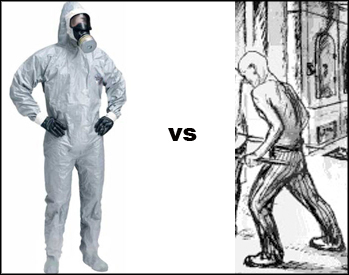
LEFT: A man dressed in a Hazmat suit and wearing gloves. This protection is worn to prevent the absorption of cyanide residues through the bare skin and to stop the inhalation of deadly cyanide gas fumes emanating from the poisoned patient’s body. RIGHT: A man with a naked torso is handling allegedly gassed bodies in this illustration made by a former concentration camp inmate.
On the right, a drawing shows a man handling dead inmates who were supposed to have been gassed. This is a drawing by a former inmate of a German camp. Note the man is not wearing gloves. His torso is naked.
It is highly unlikely that people would have handled the bodies of people who had died from cyanide poisoning without wearing the proper clothing and without putting any gloves on. They would have been exposed to highly toxic chemicals that would have come out through the pores of the skin of the dead bodies, and would have become sick.
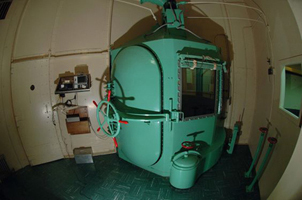
IMAGE: A cyanide gas execution chamber in the US. Note the steel door that hermetically seals the chamber. The system of pipes vents deadly cyanide gas away from the chamber.
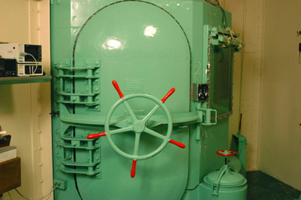
IMAGE: San Quentin gas chamber. Only chambers of this kind can be used for executing people with dangerous gases such as cyanide gas.
Based on the evidence above, the story of prisoners being gassed in shower rooms that had leaky wooden doors is not plausible. Such gassings would cause the death or serious illness of practically everyone around the shower rooms for a distance of several meters, including the guards standing outside.

This is a model of the supposed gas chambers that were said to have been used to execute millions of people. Gas escaping from the leaky chambers would have poisoned anyone working nearby, such as a guard standing outside. The chambers would have to be aired for many hours to be usable again.
Below is a typical gas chamber used for executing prisoners in the US. This is a chamber that can be tightly sealed to ensure that no lethal gas can escape and kill the people outside operating the chamber or witnessing the execution. The chair has straps to keep the prisoner tightly secure and prevent them from trying to escape, by breaking the windows, for example.

A gas chamber for executing prisoners in America. Cyanide gas was used in these gas chambers. It was the same gas used to fumigate clothes and other personal belongings in the German camps of WWII. The door could hermetically seal the chamber, which was important to prevent the escape of lethal gas to anyone outside the chamber in the execution room.
You can see how the chambers could be hermetically sealed and that they have ventilation pipes coming from them to vent the gas safely away after the execution.
Chambers would have to be equipped with straps to restrain the prisoners being gassed to stop them trying to escape.
The shower rooms that were claimed to be where camp inmates were gassed were just that––shower rooms.
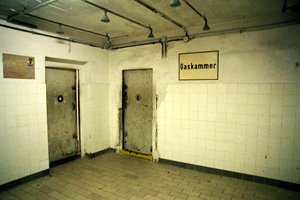
IMG: A shower room which was supposed to be a gas chamber (Mauthausen Camp). The shower heads were there to fool people, according to some camp inmates. However, it is unlikely they were used for this purpose. The doors, when closed, do not hermetically seal the room. There is no blue staining of the walls. There are no restraints holding the prisoners down either. (Photo from Further Glory)


Left: Germar Rudolf, a famous revisionist researcher and chemist, formerly employed at the Max Planck Institute, collecting samples from the external surface of a wall of a disinfecting chamber (the chamber disinfected clothes) at Birkenau Camp. The blue color is from cyanide residues. Hydrogen cyanide is also called Prussian blue. Right: The brick wall of a delousing chamber (delousing of clothes and personal belongings were done) in Birkenau (the photo was taken in August 1991). Small amounts of cyanide which diffused through the walls left tell-tale blue discoloration of the brickwork. (Photos: Germar Rudolf)
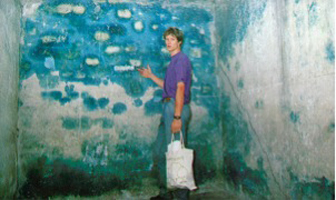

Left: Germar Rudolf inside a chamber for disinfecting clothes and personal belongings. Right: A shower room in Dachau where it is alleged inmates were gassed. Note the absence of blue discoloration of the walls. (The red arrow is pointing to a pipe which is supposed to have fed gas into the room.)

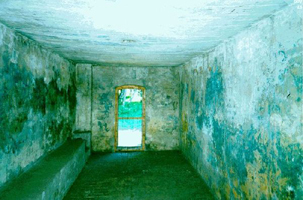
Left: Prussian blue discoloration of the brick wall of a chamber for disinfecting clothes and personal belongings at Majdanek Camp. Right: The interior of a chamber for delousing clothes, etc. Much Prussian blue staining can be seen. (Photos from Germar Rudolf)
The National Socialists were noted for being advanced in science and technology and for having a cultural ethos of high-quality workmanship. They would not have built leaky gas chambers with wooden doors, and without proper ventilation pipes to pipe away lethal gas – the same as no gas chamber in America would be built with those things omitted.

IMAGE: Compare the steel door of the San Quentin gas chamber on the left with the wooden glazed door of the supposed gas chamber in Auschwitz on the right. (Picture on right: Auschwitz)
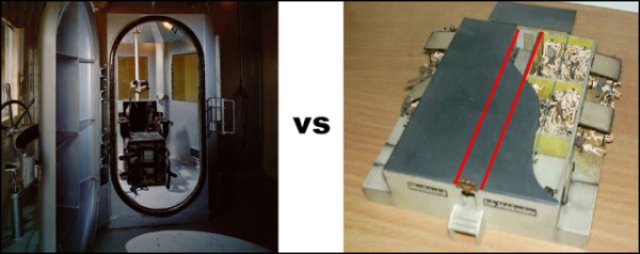
The state of the art in execution gas chambers on the left versus a model of the supposed execution gas chambers on the right. The shower rooms lacked the features that would make them feasible as gas chambers.
____________________________________
Video: “One-third of the Holocaust”
For a more detailed explanation about how the Holocaust story is false, watch the “One Third of the Holocaust“ series of videos at Holocaust Handbooks.

#camps
(For “Debunking the Holocaust II”, go here)
__________________________________
National Socialist concentration camps – what were they really like?
Activities that could be done in the camps include swimming, playing soccer, tending a greenhouse, horse grooming, playing in an orchestra, taking part in plays, and breeding rabbits. There were even brothels, dental clinics (equipped with modern dental equipment), libraries, and post offices in the camps. The camps had their own currency system.
Conditions deteriorated only in the later stages of the war due to food production and distribution being disrupted by Allied bombing.
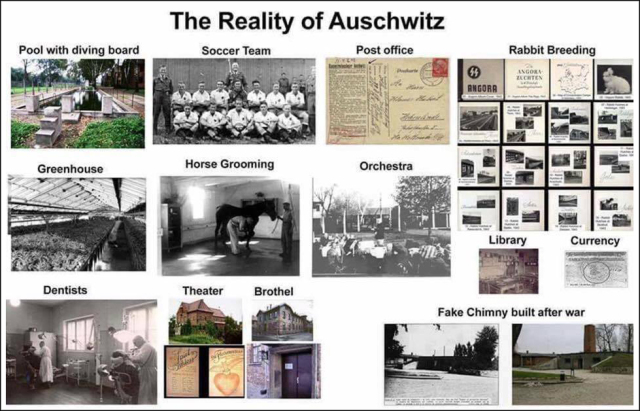
Photos of Auschwitz
The photos of camp life, all from Holocaust Museums, speak for themselves. They are photographic testimonies of the camp inmates.
Read what this former camp guard says about the internment camps: Ten-Star Hotel.
Photographic testimony of camp life donated by inmates themselves
All photos and artwork are from Holocaust museums
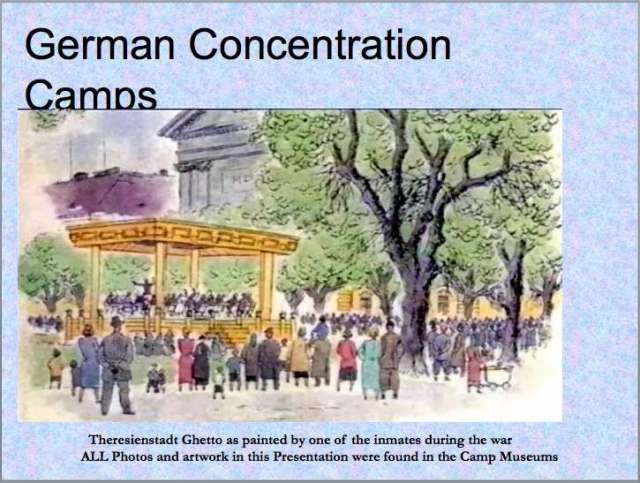
Camp rules

Most camp inmates on liberation were not skeletal in appearance
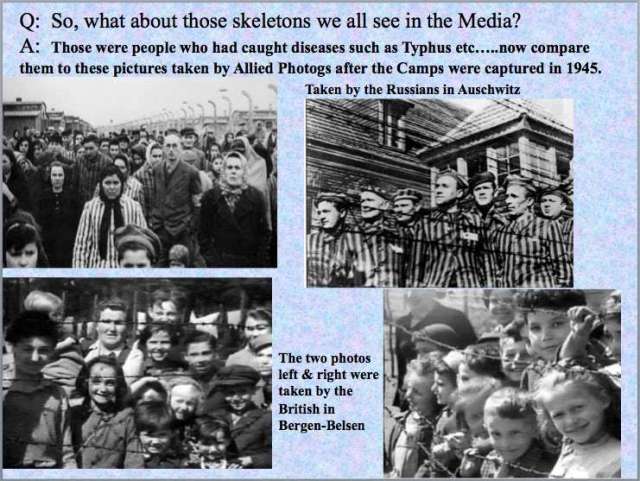
Marriage and children
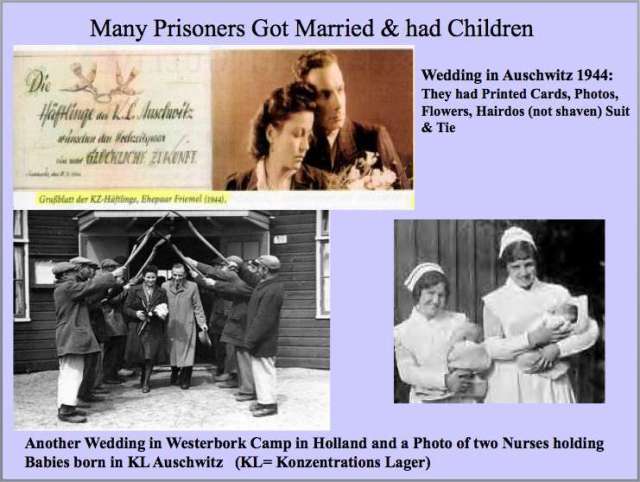
Food in the camps

Swimming pools
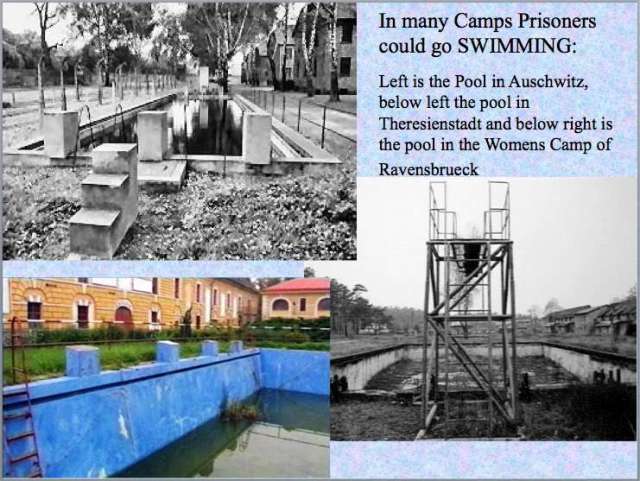
Football games and concerts

Knitting, art, and gardening

Brothels

Brothel in Neuengamme Camp

Health check by a doctor before visiting a brothel; room in a brothel

Orchestra of Neuengamme

Christmas

New Year’s Party

Hannukah; school class

Hospital, dental surgery
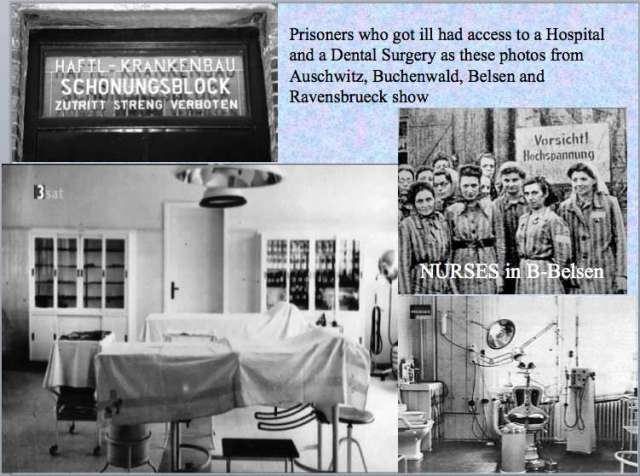
Release form and farewell ceremony

Graham Hart – Hoax Train
VIDEO: Bitchute
_________________________________
Red Cross: 270,000 died in camps
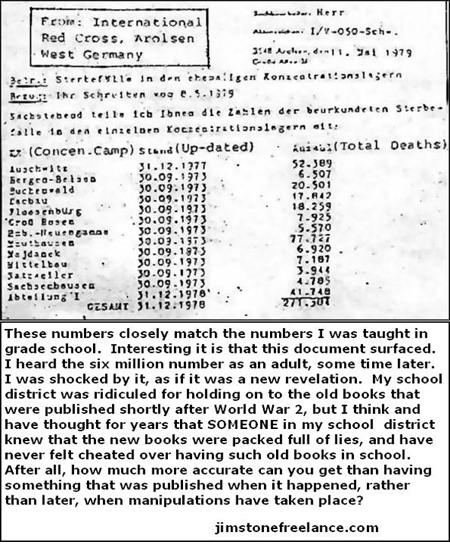
Translation of the above document:
From: International Red Cross, Arolsen, West Germany
Date: 11 July 1979
Compiled from the records of deaths kept in concentration camps
|
Camp |
Date |
Number of Deaths |
|
Auschwitz |
30.09.1973 |
52,389 |
|
Bergen-Belsen |
30.09.1973 |
6,507 |
|
Buchenwald |
30.09.1973 |
20,501 |
|
Dachau |
30.09.1973 |
17,842 |
|
Flossenburg |
30.09.1973 |
18,259 |
|
Gross Rosen |
30.09.1973 |
7,925 |
|
Neuengamme |
30.09.1973 |
5,570 |
|
Mauthausen |
30.09.1973 |
77,727 |
|
Majdanek |
30.09.1973 |
6,920 |
|
Mittelbau |
30.09.1973 |
7,187 |
|
Natzweiler |
30.09.1973 |
3,944 |
|
Sachsenhausen |
30.09.1973 |
4,785 |
|
Abtellung |
31.12.1973 |
41,748 |
|
Total |
31.12.1973 |
271,301 |
_______________________________________
Soviets released camp records for first time in 1989: 280,000 died in camps
The document, which shows death records from the National Socialist concentration camps, is stored at Arolsen, Germany. According to the Auschwitz Museum, after the fall of communism in 1989, the Soviet Union turned over 46 volumes of Death Books (Sterbebücher) to the International Committee of the Red Cross. The Soviet Union had confiscated these books from the Auschwitz camp at the end of the war.

The Soviet document that shows the number of dead in German-run camps has roughly the same figures as the Red Cross document for each camp.
__________________________________
When did the “six million” number first appear?
The “six million” figure pertaining to Jewish suffering or disasters and other adverse events affecting the Jewish population was circulated long before the internment of Jews in German camps during World War II.
Some accounts citing the six million figure can be found even before Hitler came to power (he became leader of the National Socialist Party in 1933), and before the National Socialist Party even existed (it was formed in 1920).
It was only in 1939 that Jewish and citizens of non-German countries started to be interned in large numbers in German internment camps. (Similarly, the Japanese were interned in large numbers in internment camps in America at the outbreak of hostilities between America and Japan).
The following video shows that references to “six million Jews” suffering a calamity were made in nine American and Canadian newspapers between 1915 and 1938. This was before the large-scale internment of Jews and similar people began to take place in Germany and occupied nations.
VIDEO: These Old Newspapers Read Six Million Jews Died from 1915 – 1938 Before Hitler was in power! | Bitchute
Mention of “six million Jews” appear in nine newspapers from 1915-1938
And the “European Holocaust” is mentioned in one newspaper, in 1936.
1. The Sun (New York), June 6th, 1915, fifth section of the front page:

Quote: “Since the destruction of the Temple in Jerusalem the Jewish people have had no darker page in their history than that which the Russian Government is writing today. Six million Jews, one-half of the Jewish people throughout the world, are being persecuted, hounded, humiliated, tortured, starved […]”
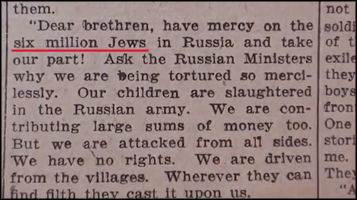
Quote: “Dear brethren, have mercy on the six million Jews in Russia and take our part! Ask the Russian Ministers why we are being tortured so mercilessly.”
2. New York Times October 18th, 1918, p.12:

Quote: “Six Million Souls Will Need Help to Resume Normal Life When War Is Ended.”
3. New York Times, September 8th, 1919, p.6:

Quote: “Mass Meeting Hears That 127,000 Jews Have Been Killed and 6,000,000 Are in Peril.”
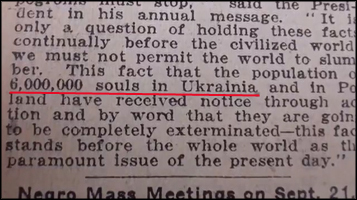
Quote: “This fact that the population of 6,000,000 souls in Ukrainia and in Poland have received notice through action and by word that they are going to be completely exterminated––this fact stands before the whole world as the paramount issue of the present day.”
4. New York Times, November 12th, 1919, p.7:

Quote: Paul Warburg: ‘”The successive blows of contending armies have all but broken the back of European Jewry,” he said, “and have reduced to tragically unbelievable poverty, starvation and disease about 6,000,000 souls, or half the Jewish population of the earth.”‘
5. Atlanta Constitution February 23, 1920, front page:

Quote: (Article is titled “$5000 Raised to Save Suffering Jews”) “[Mr. Rusland] called upon the Atlanta Jews to arise to the occasion, and to contribute to the emergency fund in order that the lives of six millions of Jewish people may be saved.”

Quote: “[Rusland] drew a graphic picture of the starvation and suffering of the 6,000,000 Jews who live in eastern Europe and Palestine and reviewed the persecution they have undergone, not only in the last four years, but for almost a century.”
6. New York Times, May 7, 1920, p.11:

Quote: “The fund for Jewish war sufferers in Central and Eastern Europe, where six millions face horrifying conditions of famine, disease and death, was enriched yesterday by a contribution of $100,000 from Nathan Straus.”
7. New York Times, July 20, 1921, p.2:
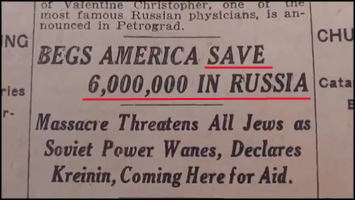
Quote: Headline: “BEGS AMERICA SAVE 6,000,000 IN RUSSIA”
“Massacre Threatens All Jews as Soviet Power Wanes, Declares Kreinin, Coming Here for Aid.”

Quote: “Russia’s 6,000,000 Jews are facing extermination by massacre. As the famine is spreading, the counter-revolutionary movement is gaining and the Soviet’s control is waning. This statement is borne out by official documents presented to the Berlin Government, which show that numerous pogroms are raging in all parts of Russia and the Ukraine.”
8. Montreal Gazette, December 29th, 1931, p.6:

Quote: Headline: “Six Million Jews Face Starvation”
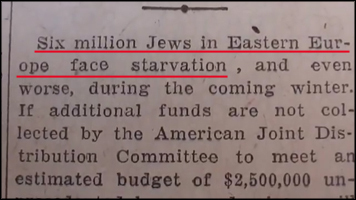
Quote: “Six million Jews in Eastern Europe face starvation, and even worse, during the coming winter.”
9. New York Times, May 1, 1936, p.14: This does not state six million but mentions the “European holocaust”

Quote: “stressed the intolerable sufferings of the Jews in the European Holocaust”,
10. New York Times, Feb 23, 1938, p.23:
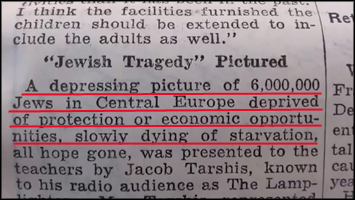
Quote: “A depressing picture of 6,000,000 Jews in Central Europe deprived of protection or economic opportunities, slowly dying of starvation, all hope gone, was presented to the teachers by Jacob Tarshis, known to his audience as The Lamplighter.”
New York Times, October 6, 1940, p.10: “New World Order”
NEW WORLD ORDER PLEDGED TO JEWS
Arthur Greenwood [Deputy Leader of the British Labor Party], member without portfolio in the British War Cabinet, assured the Jews of the United States that when victory was achieved an effort would be made to found a new world order based on the ideals of “justice and peace.”
_________________________________
Talmud: “Romans killed 40 million Jews”
Bar Kokhba was a famous fortress of the Jews that the Romans laid siege to during ancient times. In the Talmud, it is written that 40 million Jews were killed during this siege. This resembles the “Nazis killed six million in the Holocaust” story. There is a history of Jews inflating and exaggerating the numbers of Jews killed and the atrocities they suffered at the hands of their opponents.

This drawing is from “Tales of the Holohoax”.
(For “Debunking the Holocaust II”, go here)
__________________________________
Auschwitz officially reduces death toll but total stays fixed at 6 million
In 1992, the Poland Government reduced the number dead at Auschwitz by 250%, from 4 million to 1.5 million. This gives lie to the 6 million figure instantly. However, Holocaust promoters still use the “six million” figure. And in many countries, one faces prosecution for denying that six million Jews died in the camps. The International Red Cross gives a much lower figure for the dead at Auschwitz: it says 135,000, which is 50% of the total deaths (270,000).
Red Cross: 135,000 prisoners died in Auschwitz
Records, kept by the political department (Gestapo) at Auschwitz, show that there were around 69,000 registered prisoners who died between July 29, 1941 and December 31, 1943.
The Death books from June 14, 1940 to July 28, 1941 are missing, as are the death books from all of 1944 and January 1945.
Based on these records, the International Red Cross has estimated that a total of around 135,000 registered prisoners died in the three Auschwitz camps. These figures are for Jews and non-Jews.
Source: http://www.scrapbookpages.com/AuschwitzScrapbook/History/

Newspaper article with headline announcing that the number of deaths at Auschwitz had been reduced to a million.
In 1948, Auschwitz displayed a memorial tablet that mourns “four million” killed “at the hands of the Nazi murderers between the years 1940 and 1945”.
Later, in 1989, after the USSR released the Death Registry Volumes, the plaque was changed to one that said that “one and a half million men, women, and children, mainly Jews” perished in the camp, a reduction in deaths by 2.5 million.
Holocaust researchers, e.g. Ernst Zundel, have been imprisoned for only questioning the six million figure.

The memorial plaque in Auschwitz that was erected in 1948 says that 4 million inmates died. 1948 was the year that Israel was established. This figure was changed to 1.5 million in 1989 after the USSR released the Death Registry Volumes. However, Holocaust revisionists are imprisoned for doing what the Auschwitz museum did: revising down the number of the people who died in the camps. Because they simply questioned the number who died in the camps, Holocaust revisionists are branded as “antisemites” and “deniers” (of the truth).
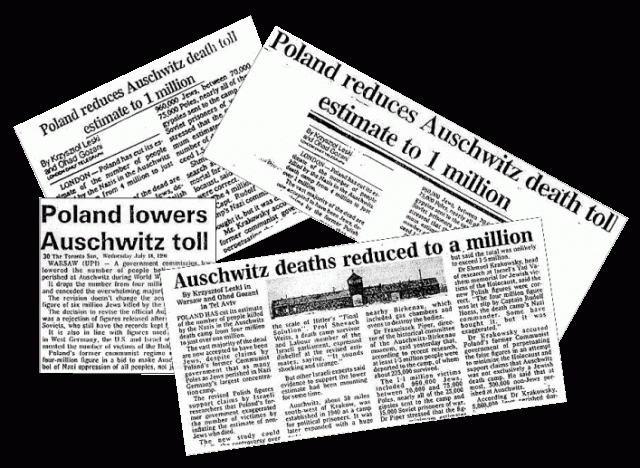
Newspaper articles about Poland lowering the Auschwitz death toll.
___________________________________
150,000 Jews were in Hitler’s Army
According to Bryan Mark Rigg, author of “Hitler’s Jewish Soldiers”, there were 150,000 Jews in the German military, some of them officers.
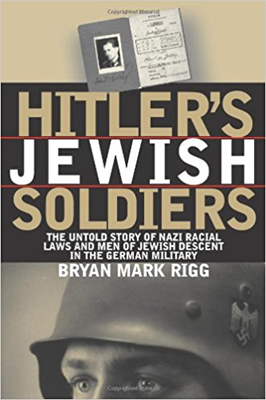
“Hitler’s Jewish Soldiers” by Bryan Mark Rigg The Greatest Story Never Told
Even though National Socialist Germany had race laws, it seems that these were interpreted loosely. For example, half-Jews were not allowed to serve in the National Socialist Army. However, many Mischlinge (half-Jews) DID serve in the regular Germany army (Wehrmacht). The fact that these people were half-Jews was overlooked by the people in charge.
Some notable people who were Jews and served in the National Socialist Army include Helmut Schmidt, who became Chancellor of East Germany.
|
AS MANY AS 150,000 JEWS SERVED IN HITLER’S MILITARY
June 26, 2014 From “Truth Will Out In Adolf Hitler: The Greatest Story NEVER Told” If you leave out parts of an equation the resulting answer you get is always incorrect. Here are some of the missing parts that make up the $3 Bill we know as “World War II & the Holocaust” As many as 150,000 Jews served in Hitlers military, some with the Nazi leader’s explicit consent, according to a U.S. historian who has interviewed hundreds of former soldiers. Bryan Mark Rigg, history professor at the American Military University in Virginia, told Reuters on Thursday. Read more at: |
_________________________________
“Arbeit Macht Frei” – Working hard could earn you early release from prison camp
The sign above the camps was “Arbeit Macht Frei”, which means “Work Makes You Free”. This sign was put at the entrance to the camps to indicate that prisoners would be released early for working hard. The camps were labor camps. The Germans wanted to utilize the labor of the prisoners to produce the weapons and other materiel needed for the war effort.
More about the Auschwitz camp at the Carlos W. Porter site.
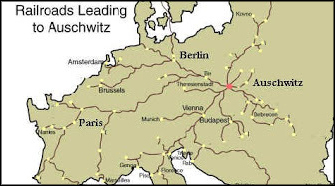
Auschwitz, a town in Poland, was chosen as a site for a work camp by the Germans because it was a railway center. Auschwitz was located where several railways lines from all around western Europe intersected, making the transportation of raw materials and goods to and from the camp convenient.
Auschwitz was a major manufacturing center, producing synthetic rubber, and medical and armament supplies.
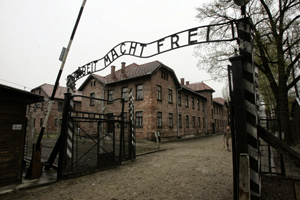

Signs near entrances of camps informed incoming prisoners that hard work would be rewarded with early release.
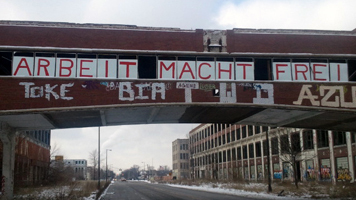

The signs read “Work makes you free”. The factories in the camps made industrial goods such as aircraft parts that were important in the war effort.

“Working makes you free”. These signs promised prisoners the reward of early release if they worked hard.
If the camp inmates did their quota of work and behaved well, they were released after a set time or given early release. These discharges occurred during camp-leaving ceremonies where the prisoner received a certificate and a formal farewell from the camp commandant.
The German camps were work camps and work camps only
VIDEO: Bitchute
“Graduation” from the camps
Prisoners were released from the camps after they had finished their time.

Above is a release certificate from Auschwitz, and below is a photo showing the camp commandant of a camp in Hamburg shaking hands with the prisoners who are being released from the camp. (Photos are from a Holocaust Museum)
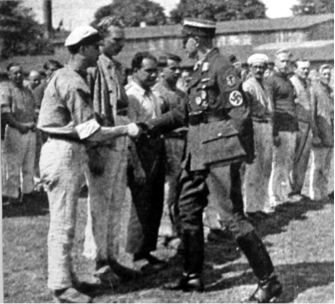
A camp commandant shaking the hands of prisoners who had been released from the camp. (Photo from a Holocaust Museum)
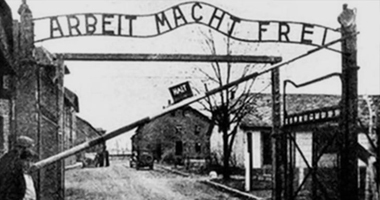
“Arbeit Macht Frei” – “Work Makes You Free”. Prisoners were promised with early release from the camps if they worked hard in the camps. These signs are evidence that these camps were work camps.
__________________________________
The National Socialist camps were work camps: more evidence
It was to Germany’s advantage that prisoners be healthy so that they could work in the factories built in the internment camps to produce weapons and other goods needed for the war effort.
Long before World War II, Germany had labor camps for dissidents. In these labor camps, people were set to work.
In socialist Germany, everyone was assigned a job. If people agreed to the system, they were paid by the government in new government-issued currency. This system was very popular as it helped reduce unemployment, which was one of the main problems of the hyperinflationary period of the Weimar era. It gave people the chance to feed themselves and their families, and put a roof over their heads, and very importantly, it gave them dignity. By the end of 1939, unemployment, which had been 50% at its peak, was practically wiped out (ihr.org).
Despite the claims that the concentration camps were extermination camps – claims mainly made by the people who support the Holocaust gassing story – much evidence exists that these camps served as work camps, much in the same way as the internment camps in Germany functioned before the outbreak of war. Jews started to be interned in German camps in 1939.
Some pictures of people working in the factories within the concentration camps
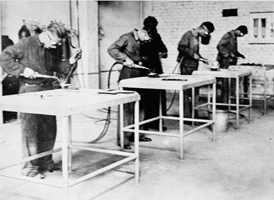
Prisoners at work in Monowitz factory Auschwitz III Auschwitz – Monowitz
The decision to build chemical factories at Auschwitz transformed both the camp and the town. On February 2, 1941, Herman Göring ordered the Jews in the town to be relocated to a ghetto, and German civilians moved into their former homes.
Auschwitz quickly went from a primitive Jewish town of 12,000 inhabitants to a modern German town of 40,000 people which included an influx of German engineers and their families. Both the main Auschwitz camp and the Birkenau camp were expanded in order to provide workers for the factories. Auschwitz – Monowitz

Prisoners working in the Siemens airplane factory at Bobrek sub-camp Monowitz
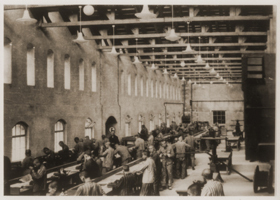
Prisoners in a camp factory

Prisoners were given coupons that could be used to buy goods as a reward; in some camps, prisoners were given fair-market wages
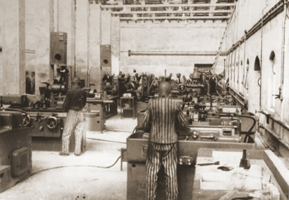
Above: Aircraft plant at a concentration camp
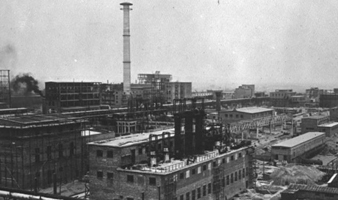
Chemical manufacturer IG Farben even had a factory inside Auschwitz (PopularResistance)

This sign, “Working makes you free”, is evidence that the internment camps run by the National Socialists were work camps.
For more about the Auschwitz and how it was a work camp, see this link: The Website of Carlos Whitlock Porter: Auschwitz and Surroundings
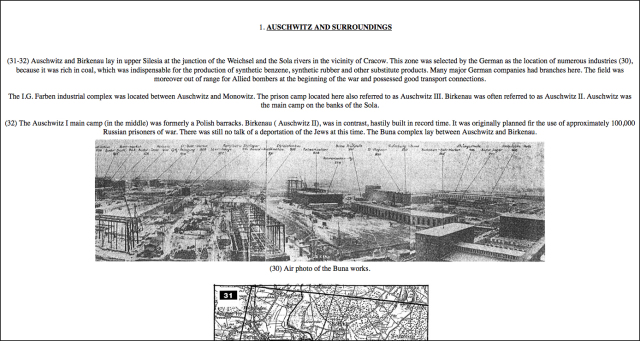
Auschwitz and Birkenau lay in upper Silesia at the junction of the Weichsel and Sola rives in the vicinity of Cracow. This zone was selected by the Germans as the location of numerous industries, because it was rich in coal, which was indispensable for the production of synthetic benzene, synthetic rubber and other substitute products. Many major German companies had branches here. The field was moreover out of range for Allied bombers at the beginning of the war and possessed good transport connections.
The IG Farben industrial complex was located between Auschwitz and Monowitz. The prison camp located here also referred to as Auschwitz III. Birkenau was often referred to as Auschwitz II. Auschwitz was the main camp on the banks of the Sola.
Read more here
________________________________
Japanese-Americans were interned in concentration camps too
- 110,000-120,000 Japanese were interned.
- 62% of those interned were American citizens
- Internment happened after Pearl Harbor, in 1941.
- On the mainland, they were forced into western interior camps.
- On Hawaii, 1,200-1,800 of the 150,000 Japanese living there were interned.
- Even orphaned infants and those who had 1/16 Japanese blood were interned.
- There was an order that Japanese people were to be excluded from the West Coast.
- The United Census Bureau assisted in the internment of the Japanese.
- There were eight US Department of Justice camps
- 7,000 German Americans and 3,000 Italian Americans were also interned in the Department of Justice camps.
- These concentration camps were often called “detention centers”.

The housing barracks, built by the U.S. Army engineer corps, at the internment camp where Japanese Americans are relocated to in Amache, Colo., are shown in this photo taken on June 21, 1943. AP photo HowStuffWorks

Image from internmentarchitect

April 5, 1942. PHOTO: CLEM ALBERS Chicago Mag
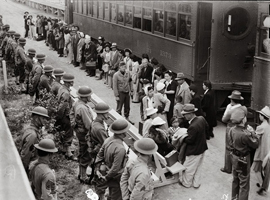
Arriving at Santa Anita was a bewildering experience. The sight of barbed wire and armed guards shocked many Japanese Americans, who had no idea what to expect or how long they would be incarcerated. CLEM ALBERS Chicago Mag
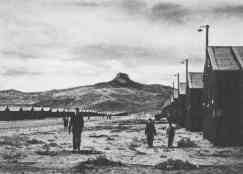
F Street, the main Heart Mountain Relocation Center thoroughfare.

Canal Camp, one of two camps at Gila River.
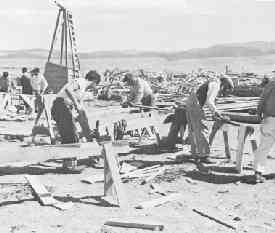
Heart Mountain, Sept 1942. Making furniture from wood salvaged from the scrap pile.

Making beds out of hay.

Sitting on homemade furniture in a 20′ x 24′ room in Tule Lake, Sept. 1942. A room of this size was often home to 3 couples.

Waiting to enter the mess hall.
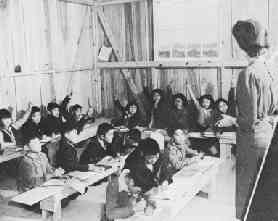
A makeshift classroom at Rohwer, Fall, 1942. (udayton)
#ddt
(For “Debunking the Holocaust II”, go here)
____________________________________
Diff’rent strokes for diff’rent folks: Germans used cyanide, USA used DDT for typhus control
During the Second World War, disinfection was done with DDT powder in America, and with Zyklon B (cyanide) gas in Europe. Killing lice and nits (lice eggs) was an important measure to reduce the incidence of typhus, a common killer before the use of antibiotics became widespread, especially where people lived in close quarters to one another, such as jails, labor camps, and institutions.
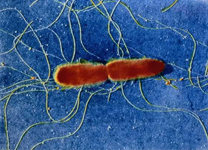


The louse is a vector (carrier of an organism) for Rickettsia prowazekii, the rod-like microorganism which causes typhus.


Lice and nits on the surface of clothes
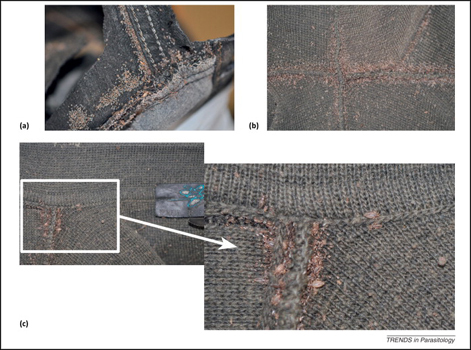
Lice and nits are found preferentially in the creases and seams of clothing.
DDT was used by Americans to disinfect and prevent typhus epidemics
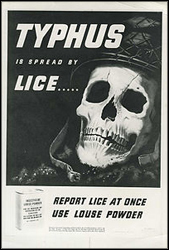

Americans used DDT powder or “louse powder” for disinfection during WW2.

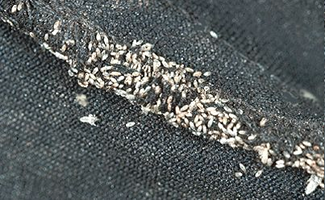
Left: Body louse; Right: Nits and lice in the seams of fabric.


Left: DDT use by Americans to control typhus epidemics. Right: A Soviet prisoner being doused with DDT by Allied soldiers to control lice after liberation (Dachau Scrapbook)
Zyklon B (hydrogen cyanide) gas cubicles to de-louse clothes in Germany
The doors to the clothes-de-lousing chambers had signs on them warning of dangerous gas being used inside.
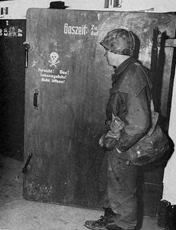

An American soldier enters a disinfection chamber for the delousing of clothes and other items. Note the heavy steel door and the warning written on the door “Gaszeit” (“Gas site”) and “Vorsicht! Gas! Lebensgefahr! Nicht offnen!”, or in English: “Warning! Gas! BioHazard! Don’t open!”
Doors were later painted to hide the warnings on the doors
The doors in the pictures below belong to the same chambers above that the American soldier is standing outside of. After the war ended, the warnings on the doors were painted over.

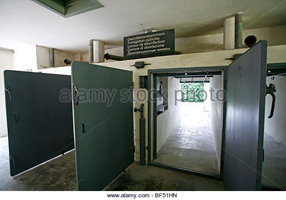
Disinfection cubicles for fumigating clothes, sheets and other personal belongings at Dachau. Notice the small size of the cubicles and the heavy steel doors. In the photo on right, a Degesch machine, that dispensed gas to the cubicles, can be seen in the corridor between the row of cubicles. The outside walls showed blue patches from Prussian Blue (hydrogen cyanide) staining.
“Warning! Gas! Biohazard! Do not open!”
The warning on the doors is “Warning! Gas! BioHazard! Don’t open!”


The sign on the door to the clothes-disinfecting chamber said in German: “Vorsicht! Gas! Lebensgefahr! Nicht offnen!” or in English: “Warning! Gas! BioHazard! Don’t open!”. Signs like this were later painted over.
The door with the sign “Gas site” that was captured in this April 30, 1945 photo below has been painted over. This door belonged to one of the cubicles that were in a row in Dachau camp. These cubicles were built to disinfect clothes and other personal belongings of the prisoners in order to reduce the spread of deadly typhus and save lives – not to kill inmates.

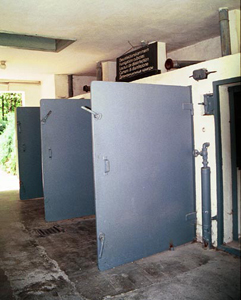
Left: The warning on the door of the de-lousing gas cubicle that disinfected clothes said “Gas site” and below that: “Warning! Gas! Hazard! Do not enter!” Right: The same place but the doors have been painted to hide the signs written on the doors.

Workers at the delousing chamber. Visible are racks and hangers on which to drape clothing etc. Note the heavy steel doors and the narrow width of the cubicles.
Cyanide pellets used for killing lice
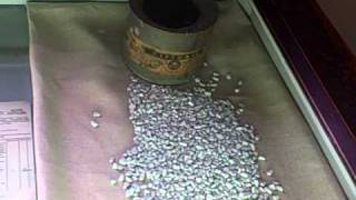

Zyklon B pellets. “Zyklon” (hydrocyanic acid gas), a widely available commercial insecticide and rodent killer, was used extensively at Auschwitz to kill typhus-bearing lice. Zyklon B was also called Prussian Blue for the blue color it would leave behind. IHR
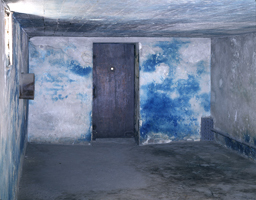

Left: A delousing chamber at Majdanek camp, Poland. Note the metal door. Hydrogen cyanide leaves a blue colored residue. Hydrogen cyanide was first isolated from a blue pigment (Prussian blue). Right: Germar Rudolf taking scrapings of hydrogen cyanide from the wooden door jamb (Auschwitz-Birkenau camp).
Wooden doors and doors with window in alleged gas chambers

On the left is a Baltimore gas chamber. On the right is an alleged gas chamber at Auschwitz. Note the wooden door and the window in the door. This wooden door would not be able to hermetically seal the room.

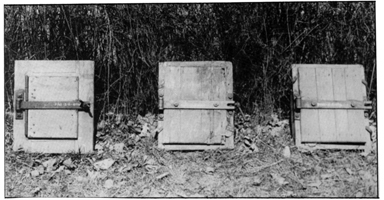
Wooden doors of the supposed homicidal gas chambers, as claimed by the supporters of the Holocaust narrative. Deadly gas would have quickly permeated through the wooden door to the outside, poisoning people close by, such as guards and workers. Homicidal gassing chambers need to be hermetically sealed during the gassing. (Images: CW Porter)
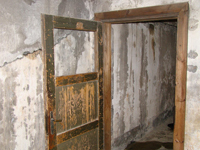
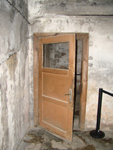
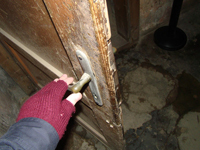
Wooden doors in the “gas chambers” at Auschwitz. Some of the doors had glazing. (Images: Link)


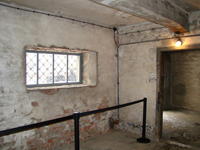
LEFT: Wooden door of “gas chamber”. CENTER: Drain in the floor of the “gas chamber”. RIGHT: Window of a room within the “gas chamber”. (Images: Link)
“Shower rooms were used to gas people”
Shower rooms were allegedly used as homicidal gassing rooms. However, there is no marked blue staining of the walls of the showers. If hydrogen cyanide (Prussian blue) had been used to kill people in this shower room, the walls and ceilings would show blue stains. The people who claim these rooms as gassing rooms explain the lack of equipment to gas people by saying the National Socialists removed these a few days before Liberation.
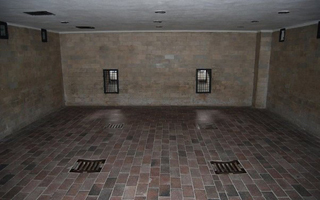

LEFT: A shower room which was allegedly a homicidal gassing room. However, there is no marked blue staining of the walls. RIGHT: “Gas chamber” at Auschwitz. Note the absence of Prussian blue staining on the walls. (Image on right: Link)


Left: Clothes-delousing chambers in a row. Right: A view from the outside of a delousing chamber. Note the Degesch machine into which cyanide pellets were dropped and the gas pipe on the outside wall. These narrow cubicles were used for the delousing of clothes and similar items. They would not have been suitable for killing large numbers of people because of the small size of the chambers. However, they could fit racks (see below) and be used for the fumigation of clothes and other personal belongings.

Left: The clothes rack in a clothes delousing chamber. The rack could be slid in and out. Note the hangers. Right: Gas pellet dispensing machine (Degesch machine). This machine is on the outside wall of a clothes fumigation chamber. Pipes fed the insecticidal gas to the disinfection chambers.

Deloused clothing hung up outside the four disinfection chambers, April 1945. Dachau(Whale). Even after the disinfection process, the clothes had to be aired and beaten. (Arthur Butz).
A Degesch machine for input of pellets and gas dispensing for the delousing operation. The gas would then be piped into several chambers that deloused clothes. Link
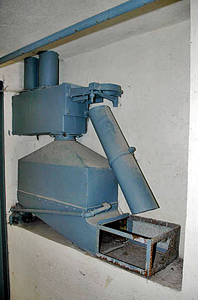
Degesch machine. Degesch was a German company that developed Zyklon B. It was made available to the public in 1923 (Prof. Butz’s Short Introduction to Holocaust Revisionism).
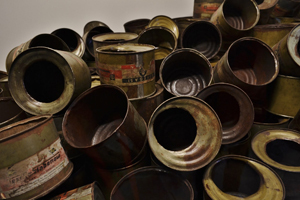
Empty cans that stored hydrogen cyanide pellets (Zyklon B), also known as Prussian Blue.

A label on a can like the ones above containing Zyklon B pellets. Zyklon is German for cyanide. Cyanide was used as an insecticide in Europe during WWII. USA used DDT powder as an insecticide, eg to kill lice to suppress typhus epidemics.
Other Europeans used Zyklon B too
The Finnish, like many other Europeans, used Zyklon B as an insecticide to control the typhus infection. Before antibiotics came to be widely used, typhus was a major problem around the world. Starvation reduced resistance to disease and increased the likelihood of contracting typhus. Tuberculosis, typhoid fever (a gastrointestinal illness) and dysentery were other causes of morbidity and fatalities in the camps. Typhoid illness (a gastrointestinal infection) is often confused with typhus but the two diseases are quite different.
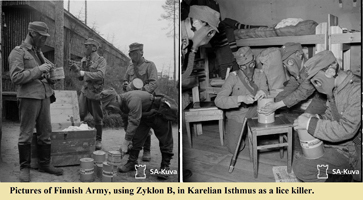
Pictures of Finnish Army, using Zyklon B, in Karelian Isthmus as a lice killer. Note the gas masks worn.
Hot steam autoclaves for disinfecting
The Germans used the autoclave method for the disinfection of clothes as an alternative to the Zyklon B system. In this system, hot steam under high pressure was used to kill the lice in clothes. In the picture below left of an autoclave, a rack for the hanging of clothes and other materials to be deloused is inside the autoclave. The racks could be moved in and out of the autoclave chamber. Note the similarity to American execution chambers. A tight seal is needed for the autoclave.
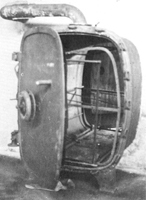

LEFT: German autoclave (hot steam under pressure) is used as delousing chamber for the disinfection of clothes. Photo: CW Porter RIGHT: Mississippi gas chamber for executing prisoners. The door can be closed to make a tight seal.

Workers are tending to the autoclave (steam disinfection) chambers at Birkenau. CW Porter
Disinfection tunnels
Germans also used a tunnel for large-scale disinfection of certain items. Carriages would pass into these tunnels on tracks. The heavy door would be closed. Then gas would be released into the tunnel for delousing.
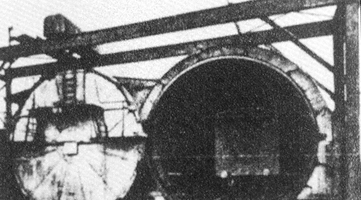
Disinfecting tunnels. Note the heavy steel door on the left. It was suspended from the rails above. CW Porter

The interior of the disinfection chamber. Several carriages could fit inside longitudinally. CW Porter

The disinfection tunnel with the door closed. CW Porter

Another tunnel-shaped chamber used for fumigation. This could fit railway carriages inside, making the fumigation procedure more efficient. This one was in Budapest. Note the exhaust pipes at the sides, venting the cyanide gas to the outside. CW Porter
References
1. The Website of Carlos Whitlock Porter: Auschwitz and Surroundings (link)
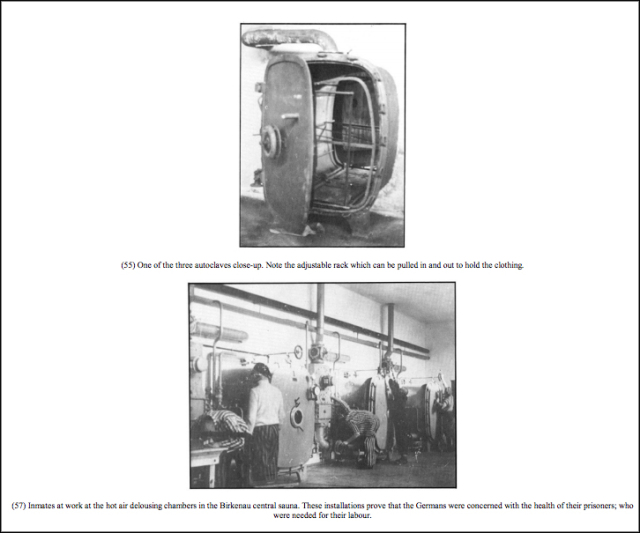
2. Whale: Gas shelters and delousing chambers (link)
It should also be remembered that a man may be overcome by the absorption of hydrocyanic gas through the skin; a concentration of 2 percent hydrocyanic acid gas being sufficient to thus overcome a man in about 10 minutes. Therefore, EVEN IF ONE WEARS A GAS MASK, exposure to concentrations of hydrocyanic gas of 1 percent by volume or greater should be made only in case of necessity and then FOR A PERIOD NO LONGER THAN 1 MINUTE AT A TIME. In general, places containing this gas should be well ventilated with fresh air before the wearer of the mask enters, thus reducing the concentration of hydrocyanic gas to low fractional percentages.
Read more here
#shavedheads #hair
(For “Debunking the Holocaust II”, go here)
__________________________________
Heads were shaved to keep lice infestation down
German camp commandants shaved the heads of camp inmates to keep lice infestation down. Head lice were carriers of typhus, a deadly disease that was common in the camps. Controlling head lice also controlled body lice.

Hungarian Jewish women head to their barracks after their heads were shaved furtherglory

Human hair from Auschwitz in the Holocaust Museum
They received a haircut, then entered a shower building … In the meantime, their clothing was disinfected (in the building in the middle with the four smokestacks). The inmates finally left the building on the other side – the ‘clean side’. All areas inside the building were equipped with central heating (later removed, with or without evil intent), all work was done by the inmates themselves.
To remove body lice you have to get rid of head lice

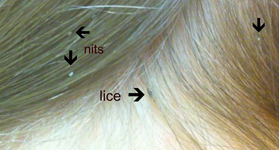
Lice eggs or “nits” in hair.


A sign warning that typhus is carried by lice. Typhus is a disease caused by rickettsial organisms.
Quotes are from National Geographic: Head lice trigger body lice epidemics
Body lice causes typhus epidemics
Quote: Body lice, which cause highly lethal epidemics (trench fever, typhus and relapsing fever Borrelia), originate from head lice, an international group of scientists reported today. (NatGeo)
Body lice originates from head lice
Quote: The discovery indicates that it is not possible to eradicate body lice without first eradicating head lice, which until now has proved impossible, according to the researchers. (NatGeo)
Body lice and head lice are the same species
Quote: “Until now, head lice, which feed on the scalp and lay their eggs on hair, and body lice, which feed on the rest of the body and live in the creases of dirty clothes, were thought to be different species. However, researchers from the Emerging Infectious and Tropical Diseases Research Unit […] and two U.S. teams have shown that these lice have the same origin,” CNRS said. (NatGeo)
Genetics of head and body lice are same
Quote: Through genetic analysis of the louse genome, the researchers observed that “it was impossible to distinguish the head louse from the body louse at the genetic level,” CNRS added. (NatGeo)
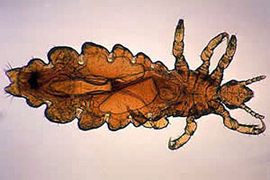
Image of head louse (Pediculus humanus capitis) courtesy of CDC (NatGeo)
Head lice turns into body lice by migrating to body
Quote: In addition, fieldwork has shown that, in populations living in extreme poverty, the proliferation of head lice led to the emergence of lice able to adapt to clothes and turn into body lice. These body lice were then able to cause epidemics of body lice and bacterial epidemics. (NatGeo)
New discovery shows body lice can’t be eradicated directly
Quote: This discovery shows that it is not possible to eradicate body lice without first eradicating head lice, which until now has proved impossible. In addition, this explains the regular appearance of body lice in areas where they were previously unknown, when sanitary conditions rapidly deteriorate. (NatGeo)
Head lice permanently endemic
Quote: “Head lice are therefore permanently in an endemic state. In highly unfavorable sanitary conditions, head lice proliferate, and some of them migrate into clothes, triggering a new epidemic of body lice,” CNRS said […]. (NatGeo)
How do you get head lice?
Quote: Getting head lice is not related to cleanliness of the person or their environment, according to the CDC. (NatGeo)
Head lice spread by direct contact: camp, playgrounds, slumber parties
Quote: Head lice are spread by direct contact with the hair of an infested person. The most common way to get head lice is by head-to-head contact with a person who already has head lice. Such contact can be common among children during play at school, home, and elsewhere (e.g., sports activities, playgrounds, camp, and slumber parties). (NatGeo)
Transmission spread by clothing, bedding, combs, towels
Quote: Uncommonly, transmission of head lice may occur by wearing clothing, such as hats, scarves, coats, sports uniforms, or hair ribbons worn by an infested person; using infested combs, brushes or towels; or lying on a bed, couch, pillow, carpet, or stuffed animal that has recently been in contact with an infested person, the CDC says. (NatGeo)
Lice and nits


Nits (lice eggs) in hair. They are slightly smaller than the size of sesame seeds. On the right, close up of nits.
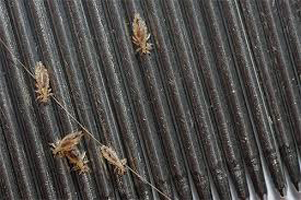
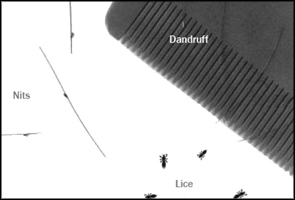
Lice caught on a comb. Nits will stick to hair strands unlike dandruff.
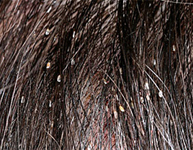

Head with nits and lice.
_________________________________
None of the German camps had execution rooms like the ones found in Soviet-occupied Latvia
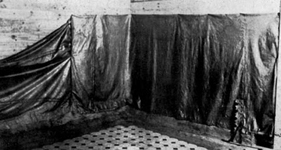
The execution room of a detention and torture center run by the Soviet Union in Latvia. Bolsheviks occupied Latvia between 1940-1941. Execution was done by shooting. The room was carefully designed. Wooden boards covered the walls to absorb the bullets. The doors had wood panelling. Wood is well-known to muffle sound. The floor was covered with tiles so that the blood could be easily washed off. Curtains hung down the walls to prevent splashes of blood going onto the walls. The Horrible Year

A drain hole in the corner of one of the execution rooms in the detention center of the Soviets. 240 bullets were found in the groove that was near the hole. Countless bullets probably fell into the drain hole. The Horrible Year
(For Part II of “Debunking the Holocaust”, go here)
_________________________________
Camp commanders improved quality of food to reduce death rate
Himmler – “Reduce Deaths at all Costs”

Heinrich Himmler
Heinrich Himmler, chief of the Concentration Camps, issued orders on December 28, 1942, that:
“The death rate in the concentration camps must be reduced at all costs”
(Reitlinger, “The Final Solution”). Link
Pohl Report: Raw food and sauerkraut added given to increase vitamin content of food for inmates

Oswald Pohl, head administrator of the concentration camps
“This reduction in the mortality rate is due primarily to the fact that the hygienic measures which have long been demanded have now been carried out, at least to a larger extent. Furthermore, it has been ordered in the field of nutrition that one-third of the food, raw and properly chopped, be added shortly before distribution, to the cooked food. Cooking too long has been avoided. Supplementary rations of sauerkraut and similar foods have been issued.”
Disease in the camps was hurting war production
The camps had been hit with a deadly typhus epidemic that was spread by body lice. Stomach pain, high fever, emaciation and death can quickly follow after acquiring typhus. All of the camps were factories and the loss of workers was hurting war production. Inspector of the camps, Richard Glucks, responded to Himmler’s order on January 20, 1943:
“Every means will be used to lower the death rates”
(Nuremberg Tribunal Document No. 1523).
Prisoners suffered from tuberculosis too contributing to “shockingly high” death rate
On April 10, 1943, Oswald Pohl, head of the Economic Administration Office of the camps, issued a letter stating that persons with tuberculosis were being sent to the camps, resulting in the “shockingly high mortality figures” (Nuremberg Documents). Later, on September 30, 1943, Pohl was able to show that the camp death rate had been reduced from 8.5% in July, 1942 to 2.8% in June 1943.
Camp commander shot for mistreating prisoners
The German SS arrested Buchenwald Commandant, Karl Koch, in 1943 for mistreating and even executing some prisoners. After an investigation, Koch was found guilty by SS Judge Konrad Morgen, and shot.
Himmler’s orders to improve conditions contradict the claims of a National Socialist extermination policy
Do the orders by Himmler to increase the food supply and overall conditions at the camps to save lives and lower the death toll sound like a policy of “extermination?”
Victors re-write history after the war is concluded to favor them
After the War, with suspicion rapidly rising about the Holocaust claim, a committee of Jewish leaders from New York and Paris met with communist leaders in Warsaw. There they established the “Committee for the Investigation of War Crimes and War Criminals”. It was after this meeting that the announcement was made that all gas chambers had been located in camps in Poland.

Daily rations of prisoners at Auschwitz. Photo is from the Auschwitz Museum. In the last years of the war, ordinary German civilians were suffering from food shortages too. The prisoners’ food was supplemented by relief packages from donors containing food that were delivered by the Red Cross.

Daily rations of camp inmates, showing what the prisoners ate for breakfast, lunch and dinner.
In 1942, Himmler allowed food parcels from outside of German-controlled territory to be sent to concentration camp prisoners. After this, food parcels arrived from family and friends, as well as from the Red Cross. The Red Cross packed 9,000 parcels for prisoners daily according to official Red Cross reports.
_______________________________
Photographic hoaxes
Below, one of the most famous images of the so-called Holocaust, is proven to be a fake. Doctoring photographs to show abuse and atrocities that did not happen is part of a phenomenon called “atrocity propaganda”. Atrocity propaganda is done to demonize a nation or a group of people. It can be used to perpetrate real atrocities.
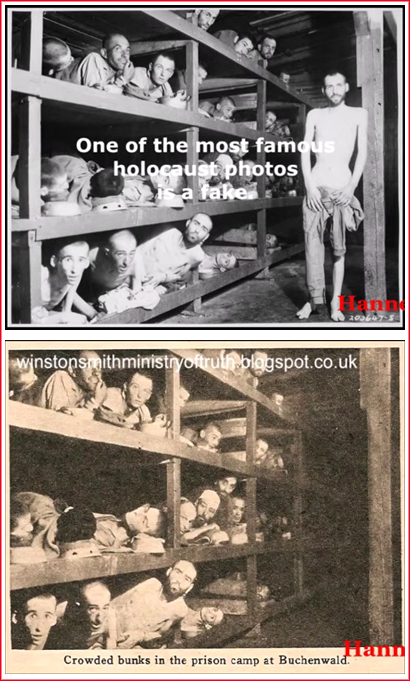
This iconic photo of the Holocaust that was first published in Life magazine is a fake.
Many of the famous photos depicting the so-called Holocaust or the “brutality” of the National Socialist Germans are actually hoaxes.

Fake photo, top. Real one, bottom.
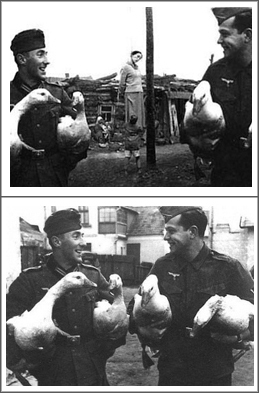
Fake photo, top. Real one, bottom.
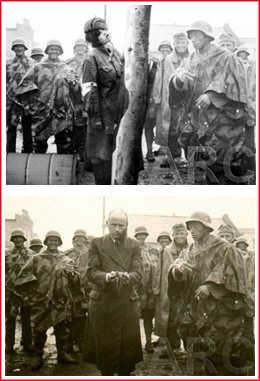
Fake photo, top. Real one, bottom.

Fake photo, top. Real one, bottom.

Fake photo, top. Real one, bottom.
The fake chimney in Auschwitz is shown below. It is not even attached to the building. It is supposed to be a chimney of a crematorium. The Soviets built it in 1947.

Fake chimney in Auschwitz, constructed in 1947
Dresden, Ohio was the site of a railway accident in 1912. The image from that accident turned up as an image depicting dead bodies in Auschwitz of 1944.

A railway disaster occurred in Dresden, Ohio, USA in 1912. The picture of the accident showed up later as an Auschwitz photo.
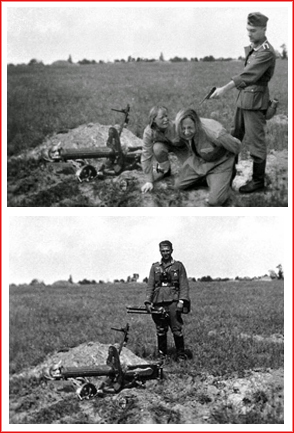
Fake picture, top. Real photo, bottom.

The photo on the right was used as a postcard by Jews in Russia.

Real photo on right; altered one on left – bodies have been added
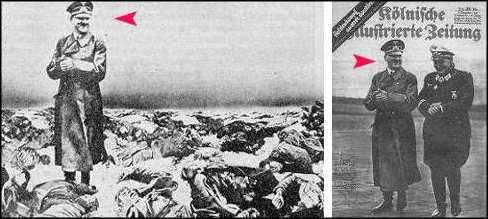
Fake photo on left; real one on right
A sketch by Simon Wiesenthal dated “1945”

Above: Unretouched photos showing three young German soldiers executed by a US firing squad, Dec 1944. From Life magazine, 1946.
Below: Oddly similar sketch by Simon Wiesenthal, daated “1945”, showing an execution in a Nazi camp. From his 1946 book “KZ Mauthausen”.
________________________________
To find out why the Nuremberg Trials cannot be relied upon, go to Debunking the Holocaust II
To see a comparison of Soviet gulags and German camps, go to Debunking the Holocaust III
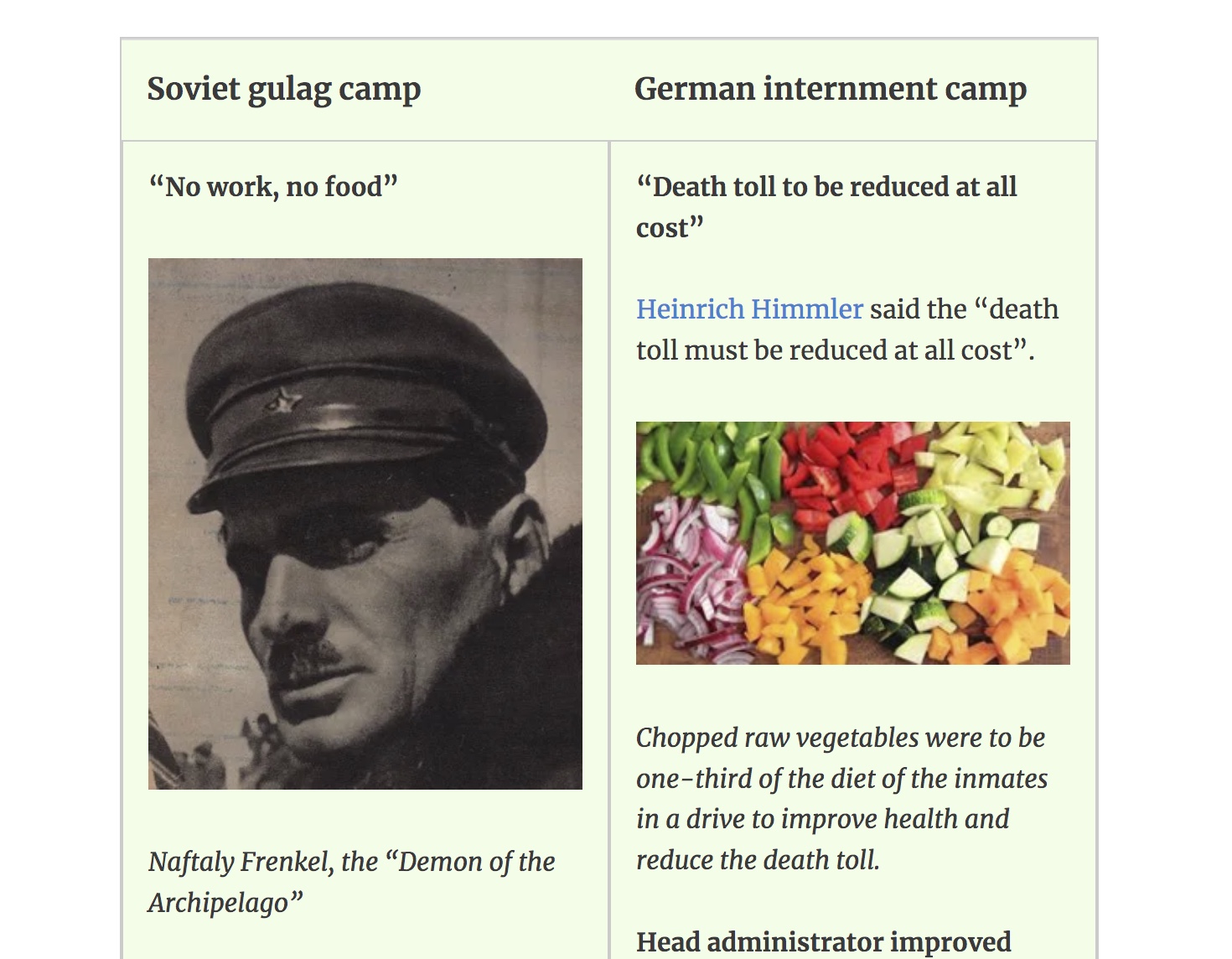
__________________________


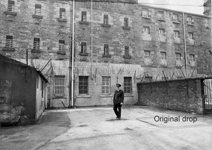
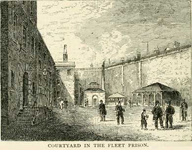

well done, I’m sold.
LikeLike